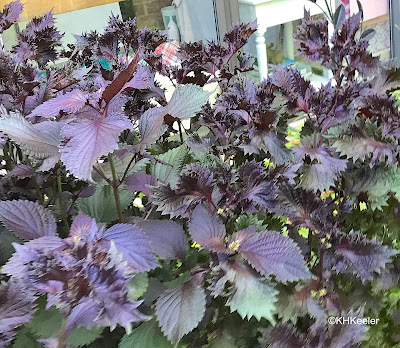 |
| beefsteak plant, shies, Perilla |
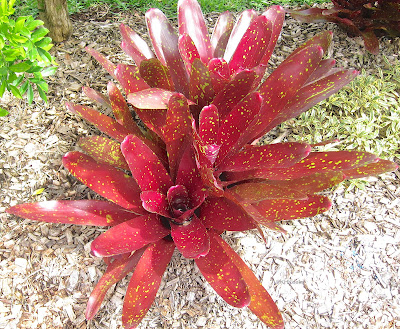 |
| bromeliad with yellow dots on red leaves |
Chlorophyll, which dominates most plant cells, reflects green light, making plants seem green to us. If chlorophyll is missing, we see other pigments. That's what happens in fall. The plants store their chlorophyll for the winter, leaving behind the reds or yellows of fall colors. We also see red or yellow leaves in plants under stress, their chlorophyll damaged or missing. A leaf in deep shade needs lots of chlorophyll to capture enough sunlight to fix carbon for the plant, so will be intensely green. A leaf in full desert sun may be reddish, needing only a little chlorophyll for all the carbon capture that it has water for, and the red pigments (anthocyanins) provide some sun-screen.
Variegated leaves are leaves with color areas of two or more colors, irregular or regular in shape.
Patterned leaves certainly exist in nature, particularly in low light conditions such as rainforest. A recent review by Zhang et al. found 1,710 species of flowering plants to have inheritedly variegated leaves (they excluded variegation due to leaf damage), or half of 1% of the approximately 300,000 plant species. This is probably a substantial undercount; in 2021 Schuiteman published a study that tripled the number of orchid species with variegation.
Variegation sometimes functions to provide better photosynthesis--that's the role of leaves after all--or aids plant defense, for example by making the shape of the leaf harder for leaf-eaters to spot. Variegation's function and how it evolved is a big topic with a lot of alternatives that need study. Research to date provides fascinating examples but only a few species have been seriously looked at.
Most if not all of the human-selected colored leaves are not very stable. Chiefly they have less chlorophyll than an ordinary green leaf, so they grow more slowly.
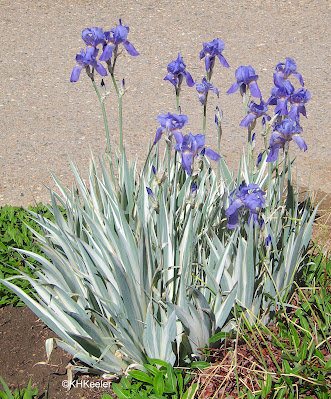 |
| iris with variegated leaves |
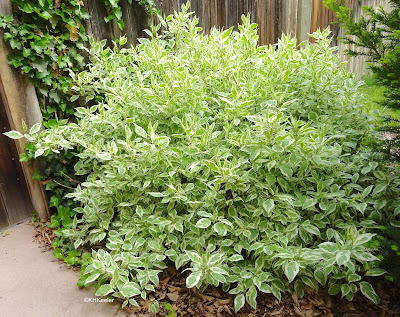 |
| variegated red osier dogwood, Cornus sericea |
For a plant, having no chlorophyll is fatal. This albino seedling I saw in a tropical rainforest was doomed. With no chlorophyll at all, it was living off the food in its seed and would soon starve. (The exceptions are parasitic plants which connect to neighboring plants and drain photosynthate from them.)
 |
| seedling with no chlorophyll |
Unusual leaf colors can last a long time in the right growing conditions, but can shift colors or become greener if conditions change. White borders on green leaves are pretty stable because the leaf has a large area rich in chlorophyll. Especially in a garden setting, that should be enough.
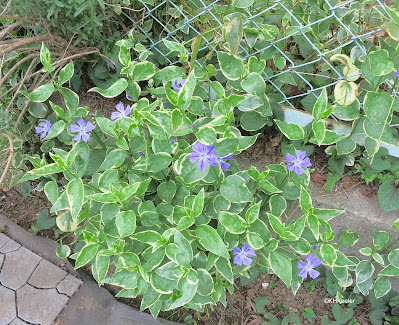 |
| variegated periwinkl, Vinca |
Chlorophyll is found in chloroplasts, which are independent little organs within the leaves, not coded for by the DNA in the nucleus but inherited as inclusions in the seed from the mother plant or coming along when cuttings are rooted. They multiply and migrate into developing leaves. So leaves with white patches incorporate defective chloroplasts or lack them altogether. That makes variegated leaves susceptible for replacement by greener leaves with more efficient chloroplasts.
Here, a seedling from the pale great forget-me-not, Brunnera macrophylla, growing in my yard, has green leaves with a little bit of white, not the white leaves with green veins of its parents, and it is growing very well indeed.
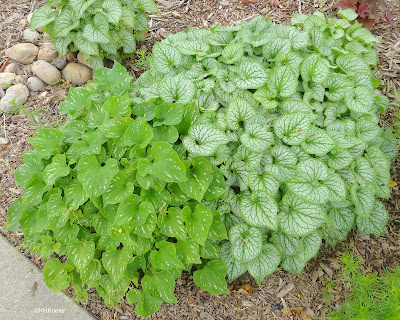 |
| Greater forget-me-not, Brunnera macrophylla came as the pale-leafed plants on the right and above, but a seedling they produced, on the left, had greener leaves. |
Here, one stalk of snow-in-the-mountains, the variegated variety of bishop's weed, Aegopodium podagraria, has mutated to form leaves with plenty of chloroplasts. Originating deep under the apple tree, they have spread to make a dramatic pattern. Over time, that bright green patch will outcompete the variegated form and replace it. I don't think I'll like having all green bishop's weed under the tree. You usually cannot restore variegation to plants or plant parts that have lost it. To maintain variegation, you have to cut out or weed out the plants without variegation. I need to do that, but I think I'll watch the pattern change for a year or two first.
 |
| Non-variegated bishop's weed (Aegopodium podagraria), is supplanting the variegated form |
That I have two variegated plants shedding their variegation for more efficient leaves probably suggests my yard is a difficult place to grow. I won't argue; I'm reducing the water I add toward "low" (natural rain in northern Colorado) and these are cultivars listed as having "moderate" water needs. In any case, watch variegated cultivars for reversion to plain green.
Fancy bright leaves are wonderful. It was fun finding the photos for this blog and you can see many more if you search online for "variegated leaves" images online or look at the photos in the references). Watch for variegated leaves in nature, where they are rare enough to be a highlight of the hike, and admire the variety that plant breeders have produced. Flowers aren't the only spectacular feature of plants.
 |
Comments and corrections welcome.
References
Schuiteman, A. 2021. Leopard spots, chequerboards, and spider's webs: classification, systematics and function of variegated leaves in Orchidaceae. Rheedea. 31: 105-132. link
Zhang, J. H., J.C. Jeng, X. M. Wang, S. F. Chen, D..C. Albach and H. Q. Li. 2020. A revised classification of leaf varigietion types. Flora. 272: 151703.
Kathy Keeler, A Wandering Botanist
More at awanderingbotanist.com
Join me on Facebook: https://www.facebook.com/AWanderingBotanist
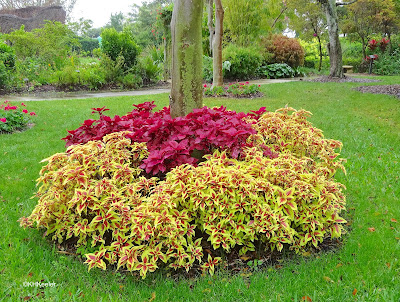

No comments:
Post a Comment